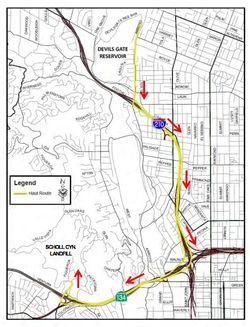Pictured: the haul route for organic sediment, which goes through Windsor Avenue.
 The Altadena Town Council will ask the Pasadena City Council to reconsider opening up a field to store silt excavated during a planned partial cleanout of the Hahamongna Watershed.
The Altadena Town Council will ask the Pasadena City Council to reconsider opening up a field to store silt excavated during a planned partial cleanout of the Hahamongna Watershed.
A county plan to remove all silt from the watershed -- a several year and several thousand truckload project -- has been held up for at least a year pending an environmental impact report. However, the county wants to remove about 26,000 cubic yards of silt as soon as possible from an area from the face of the Devil’s Gate Dam to 100 yards north, to allow repairs to the dam and restore some functionality before the winter rains begin.
The town council characterized these projects at Tuesday night’s meeting as the “big dig” and the “little dig.” The council’s preference is a plan where silt from the “little dig” is stored at Johnson Field, an area owned by the city of Pasadena on the other side of the dam. Under this plan, the silt from the “little dig” will be removed during the “big dig,” when it is hoped a road avoiding Altadena can be constructed. Getting the necessary permits from government agencies to construct the new road will not happen by October, said Town Councilman Techumseh Shackelford, who represents the area.
Otherwise, the silt will have to be removed by truck along Windsor Avenue, which would mean about 50 trucks a day going through the narrow street. Even if Pasadena approves the Johnson Field plan, ten trucks a day -- or about one per working hour -- will go through Windsor during the “little dig” to remove “organic matter” -- trees and bushes that will also be excavated.
(Last week, according to a story in the Pasadena Star News, Pasadena took the Johnson Field site off the table because officials said the required clearances would not come in time to meet the project's schedule.)
Several residents raised objections to the plan during the public comment. Lori Paul said that, even if the Johnson Field plan was used, it actually meant 20 truck trips a day going down Windsor, as each empty truck returned to be reloaded. She also said that dumping the silt in an area on the southeast corner of the dam avoided transporting the silt away from the dam and then back again to Johnson Field on the other side.
Objections were also raised to any use of Windsor, as it is one of the main roads to the Jet Propulsion Laboratory and the only route some residents on the side streets can use to leave their homes.
As for Johnson Field, some speakers objected to the site as it hosts a population of frogs.
Council chairman Gino Sund said that the council’s concern was trying to avoid having trucks going down Windsor for the estimated three or four week life of the “little dig.” The alternative routes, in the short term, simply won’t work, Sund said. The council wants to see if Johnson Field is a viable alternative, and “we don’t know that,” Sund said. “The problem is timing -- we don’t have that many options available to us.”
Shackelford said that “We have a challenge with all those trucks coming up on Windsor -- if we can get it down to ten trucks, we won’t be happy, but we can accept it.”



